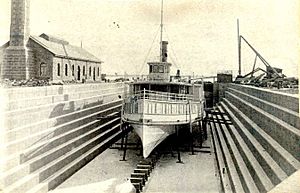Great Lakes Museum facts for kids
 |
|
| Lua error in Module:Location_map at line 420: attempt to index field 'wikibase' (a nil value). | |
| Established | 1892 (as drydock) 1975 (as museum) |
|---|---|
| Location | 55 Ontario St, Kingston, Ontario K7L 2Y2 +1 613 542 2261 |
| Type | marine museum |
| Public transit access | 3, E6 |
| Designated: | 1978 |
The Great Lakes Museum is a special place dedicated to the history of ships and sailing on the Great Lakes. It's located at 55 Ontario Street in Kingston, Ontario. This spot is also recognized as a National Historic Site of Canada.
Contents
Exploring the Museum's History
The Great Lakes Museum started as the Kingston Marine Museum. It was officially created on August 29, 1975. Its main goals were to gather, protect, and show items related to Great Lakes history. This included ships, shipbuilding, and life on the water.
The Kingston Dry Dock: A Ship Repair Hub
The museum first opened in the historic Kingston Dry Dock. This dry dock was built in 1892. It is a national historic site in Kingston, Ontario, Canada. A dry dock is like a special basin that can be drained of water. This allows workers to fix the parts of a ship that are usually underwater.
This dry dock was very important for building and repairing ships on the Great Lakes. The Canadian government built it starting in 1890. It opened in 1892. It helped keep lake vessels in good shape.
The original dry dock was made of limestone and was about 85.3 meters long. In 1910, it was made longer, reaching 115.2 meters, using concrete. Private companies operated the Kingston Shipyards here until 1968. During the Second World War, important naval ships like corvettes were built in this dry dock.
Buildings at the Historic Site
The museum site has several old buildings. The main building, built in 1891, is made of solid limestone. It used to house the powerful pumps and engines for the dry dock. An annex building was added in 1915, and a smaller building in 1938. A tall, square stone chimney, 90 feet high, stands out on the waterfront.
What You Can See at the Museum
The Great Lakes Museum has seven different galleries to explore. Each gallery tells a unique story about the Great Lakes.
Main Galleries and Exhibits
- Temporary Gallery: This gallery often changes its exhibits. It might feature special topics like warships from the War of 1812.
- Donald Page Gallery: This room used to be where air compressors and tools were kept for the shipyards. Now, it shows what sailing was like in the "Age of Sail." You can learn about sailors' lives and how ship technology changed over time.
- Eco Gallery: This is the newest gallery. It teaches about important issues affecting the Great Lakes. These include pollution, how water is used, protecting nature, and how to deal with invasive species.
- Shipwreck Gallery: This room was once the shipyard's Dynamo room. It takes you on a journey from early wooden ships to modern "Lakers." You can learn about how ships were built and what happened when they sank.
- Calvin Gallery: This gallery used to be the shipyard's boiler room. It tells the story of the Calvin family. They ran a big shipbuilding and logging business on Garden Island. You'll hear stories from Kingston's past on the water.
- Pump Room: This room shows how complex it was to operate a dry dock. The huge pumps and engines here were used to drain the dry dock. They also moved the special gate that kept water out.
Museum Ships and Collections

The Kingston Drydock buildings became a museum in the 1970s. A retired Canadian Coast Guard ship, the CCGS Alexander Henry, joined the museum in 1986. It was a "museum ship" that visitors could explore.
The museum displays cover Great Lakes shipping since 1678. You can see many interesting items. These include ship models, old engines, and tools from lake vessels. There are also glass and china pieces found from Great Lakes shipwrecks. You can see ship's bells, anchors, and navigation tools. A gallery features paintings about the sea. The museum also tells the story of the Calvin and Son shipyard, which once employed 700 workers.
The museum has even photographed historic shipwrecks. This was important because tiny zebra mussels were covering them in the 1990s. Exhibits about the War of 1812 on the Great Lakes were added for its 200th anniversary.
The museum also publishes "FreshWater," a journal about Great Lakes marine history. They have a newsletter called "Jib Gems" and several books. They keep large archives with help from Queen's University. These archives document Canadian Great Lakes marine heritage from the 1800s and 1900s.
The Museum's Journey to Reopen
In 2016, the museum faced a challenge. The federal government decided to sell the property. The museum had to move its collections into storage. Its offices moved to 53 Yonge Street.
In 2019, something amazing happened. The museum received a donation from an unknown source. This allowed them to buy back the property! The museum then began plans for refurbishment and renovation. In September 2023, the museum was officially renamed the Great Lakes Museum.
Since the museum's temporary closure, the Alexander Henry ship moved to the Lakehead Transportation Museum in Thunder Bay, Ontario. However, the Great Lakes Museum received a new special ship. The Edwardian era steamship SS Keewatin was donated. This beautiful ship arrived in Kingston on October 26, 2023. The Keewatin opened for tours in May 2024.
See also
- Wheelhouse Maritime Museum
- Maritime Museum of the Atlantic in Halifax, Nova Scotia
- Toronto Maritime Museum - former maritime museum in Toronto

